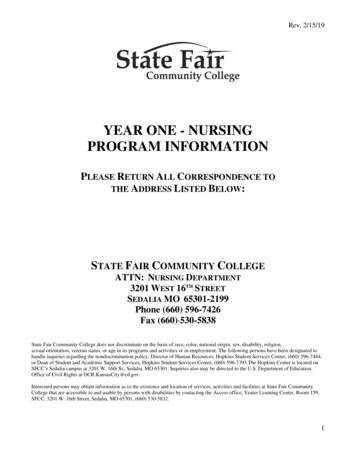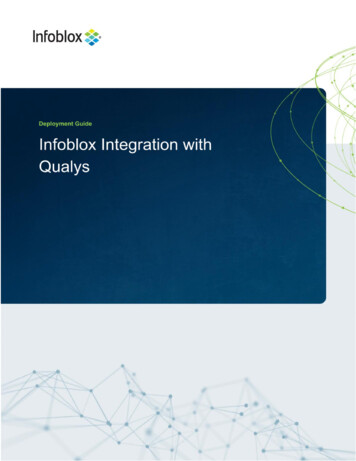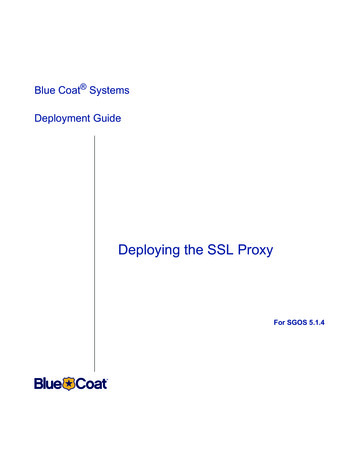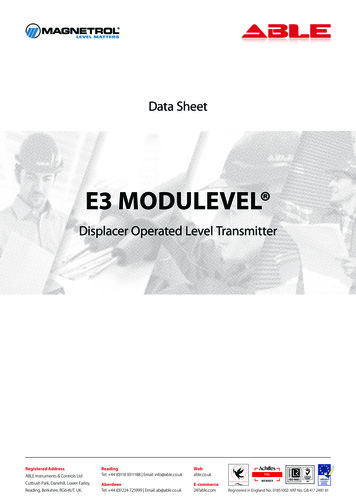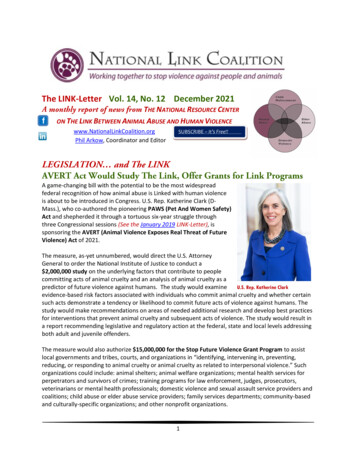
Transcription
NOMINATION OF HISTORIC BUILDING, STRUCTURE, SITE, OR OBJECTPHILADELPHIA REGISTER OF HISTORIC PLACESPHILADELPHIA HISTORICAL COMMISSIONSUBMIT ALL ATTACHED MATERIALS ON PAPER AND IN ELECTRONIC FORM ON CD (MS WORD FORMAT)1. ADDRESS OF HISTORIC RESOURCE (must comply with an Office of Property Assessment address)Street address: 2640-42 and 2644-58 E. Huntingdon StreetPostal code: 19147Councilmanic District: 12. NAME OF HISTORIC RESOURCEHistoric Name: Protestant Episcopal Church of the Messiah, Port RichmondCommon Name: Adriatic Hall3. TYPE OF HISTORIC RESOURCEBuildingStructureSiteObjectpoor4. PROPERTY cupiedvacantunder constructionruinsunknownCurrent use: Vacant5. BOUNDARY DESCRIPTIONPlease attach a plot plan and written description of the boundary.6. DESCRIPTIONPlease attach a description of the historic resource and supplement with current photographs.7. SIGNIFICANCEPlease attach the Statement of Significance.Period of Significance (from year to year): from 1847 to 1848Date(s) of construction and/or alteration: Constructed 1847-48Architect, engineer, and/or designer: John NotmanBuilder, contractor, and/or artisan: Hiram Miller (builder) and John Gibson (artisan)Original owner: Vestry of the Protestant Episcopal Church of the MessiahOther significant persons: NA
CRITERIA FOR DESIGNATION:The historic resource satisfies the following criteria for designation (check all that apply):(a) Has significant character, interest or value as part of the development, heritage or culturalcharacteristics of the City, Commonwealth or Nation or is associated with the life of a personsignificant in the past; or,(b) Is associated with an event of importance to the history of the City, Commonwealth or Nation;or,(c) Reflects the environment in an era characterized by a distinctive architectural style; or,(d) Embodies distinguishing characteristics of an architectural style or engineering specimen; or,(e) Is the work of a designer, architect, landscape architect or designer, or engineer whose workhas significantly influenced the historical, architectural, economic, social, or cultural development ofthe City, Commonwealth or Nation; or,(f) Contains elements of design, detail, materials or craftsmanship which represent a significantinnovation; or,(g) Is part of or related to a square, park or other distinctive area which should be preservedaccording to an historic, cultural or architectural motif; or,(h) Owing to its unique location or singular physical characteristic, represents an established andfamiliar visual feature of the neighborhood, community or City; or,(i) Has yielded, or may be likely to yield, information important in pre-history or history; or(j) Exemplifies the cultural, political, economic, social or historical heritage of the community.8. MAJOR BIBLIOGRAPHICAL REFERENCESPlease attach a bibliography.9. NOMINATORName with Title Oscar Beisert, Architectural Historian Email Oscar.beisert@gmail.comOrganization Rachel Hildebrandt, Architectural Historian Date September 15, 2015Street Address 257 S. 45th Street Telephone 717.602.5002City, State, and Postal Code Philadelphia, Pennsylvania 19104Nominatorisis notthe property owner.PHC USE ONLYDate of ate of Notice Issuance:Property Owner at Time of NoticeName:Address:City:State:Postal Code:Date(s) Reviewed by the Committee on Historic Designation:Date(s) Reviewed by the Historical Commission:Date of Final Action:DesignatedRejected4/11/13
Proposed for Historic Designation in the Philadelphia Register of Historic PlacesThe Protestant Episcopal Church of the Messiah, Port Richmond, Circa 1910s. Courtesy the Library Company of Philadelphia.The Protestant Episcopal Church of the Messiah2646 East Huntingdon StreetPort RichmondThe Protestant Episcopal Church of the Messiah, 2646 East Huntingdon Street, Port RichmondNomination to the Philadelphia Register of Historic Places, Fall 2015 – Page 1
5. BOUNDARY DESCRIPTIONALL THOSE CERTAIN lots or pieces of ground with the building and improvement thereonerected, SITUATE in the 31st Ward of the City of Philadelphia.ONE THEREOF SITUATE on the Southwesterly side of East Huntingdon Street at thedistance of 64 feet Northwestwardly from the Northwest side of Edgement Street.CONTAINING in front or breadth on the said East Huntingdon Street 79 feet 7inches and extending in length or depth Southwestwardly of that width betweenlines parallel to said Edgemont Street 100 feet, Know as 2646-58 EastHuntingdon Street, Parcel #19N18-0046.ANOTHER THEREOF SITUATE on the Southwesterly side of East Huntingdon Streetat the distance of 32 feet Southeastwardly from the Southeasterly side of EastThompson Street. CONTAINING in front or breadth on said East HuntingdonStreet 16 feet and extending of that width Southwestwardly between parallel linesto said East Thompson Street 100 feet, Know as 2644 East Huntingdon Street,Parcel #19N18-00144.AND ANOTHER THEREOF SITUATE at the intersection of the Southeasterly corner ofEast Huntingdon and East Thompson Street. CONTAINING in front or breadthalong the said side of East Huntingdon Street 32 feet and extending of that widthSouthwestwardly along the said East Thompson Street in length or depth 100 feet,Know as 2640-42 East Huntingdon Street, Parcel #19N18-0052.BEING 2640-42 and 2644-58 East Huntingdon Street, OPA #314145400 and #882931270.For the purposes of this nomination, the parcels at 2640-42 and 2644 E. Huntingdon Street andthe structures thereon are deemed non-contributing to the significance of the site.2640-4226442646-58The Protestant Episcopal Church of the Messiah, 2646 East Huntingdon Street, Port RichmondNomination to the Philadelphia Register of Historic Places, Fall 2015 – Page 2
6. Building DescriptionFormerly the Protestant Episcopal Church of the Messiah, and more lately known as AdriaticHall, the undesignated historic property at East Huntingdon Street, Port Richmond, is a stone andbrick masonry building situated on a large corner lot in the Port Richmond neighborhood ofPhiladelphia. Designed almost entirely in the Gothic Revival style, the building consists of thefollowing three sections: 1. The Chapel, completed in 1848, which retains its original form as aLatin Cross; 2. The 1892 Addition, a large three-story portion of the building, also in the GothicRevival style; and 3. The Entrance Addition, which was added in the mid-twentieth century,obscuring part of the original entrance to the building.Completed in 1848, The Chapel reflects an early American revivalist design in the First-PointedOrder of the Gothic Period of English Architecture, which dates to the thirteenth century.Appearing, out of context, as a small, but established rural church in both form and scale, TheChapel is built in the form of a Latin cross, which originally allowed for the chancel in the rearof the building, as well as a nave, and a transept porch (now obscured by later additions). Theroof of the building features gables at each end of its Latin cross form, which is finished in slatethat appears to be in fairly good condition. The Chapel is roughly ninety feet (90’) in length bysixty-four feet (64’) at the width of the transepts, and the highest point of the roofline is aboutfifty-six feet (56’). The entire building rests upon a full, original basement level, which wasdesigned to hold an additional, but smaller meeting room, and two classrooms. Being of loadbearing stone masonry construction, The Chapel is built entirely of rubble with rusticated andpolished brown freestone that was quarried at Trenton, New Jersey. The cornices, copings, andetc. are of the same stone, as is all of the corbelling. The apertures that once contained theleaded, stained glass windows feature a mixture of vintage and modern infill and the originalwindows have been replaced at every elevation of The Chapel. At the center of The Chapel’sprimary, Huntingdon Street elevation is a large aperture within which is a triple-lancet windowset beneath and within a larger Gothic arch recession. This aperture is set within a large gableend, which once featured a small but prominent belfry. Single lancet windows are generallywithin each elevation created by the Latin cross form. The rear, northeast elevation, which facesonto Webb Street, is roughcast. The interior retains exposed collar beams and braces, designed tofurther emulate the rural architectural form.The 1892 Addition is connected to the northwestern elevation of the transept within the Latincross of The Chapel entrance. The 1892 Addition is three-stories in height and is of loadbearingbrick masonry construction, which is visible at the northeast and southeast elevations. Theprimary elevation of the 1892 Addition, facing onto East Huntingdon Street, is finished in likebrown freestone, which may have been quarried in Trenton. The gable front of the 1892 Additionis larger in size and scale than The Chapel, but is stylized in an almost identical manner. Thenortheast and southeast elevations give off the appearance of an administration building of aninstitution, but feature some minor stylistic details. This portion of the building is noncontributing to the proposed designation.At the center of The Chapel and the 1892 Addition, the Entrance Addition obscures the lowerportion of entrance, transept porch, the parapet and roofline of which rises above. A rollinggarage door sheaths the double door entrance. This portion of the building is non-contributing tothe proposed designation.The Protestant Episcopal Church of the Messiah, 2646 East Huntingdon Street, Port RichmondNomination to the Philadelphia Register of Historic Places, Fall 2015 – Page 3
Looking southwest.The Protestant Episcopal Church of the Messiah, 2646 East Huntingdon Street, Port RichmondNomination to the Philadelphia Register of Historic Places, Fall 2015 – Page 4
Looking southwest.Looking southwest.The Protestant Episcopal Church of the Messiah, 2646 East Huntingdon Street, Port RichmondNomination to the Philadelphia Register of Historic Places, Fall 2015 – Page 5
Looking southwest.The Protestant Episcopal Church of the Messiah, 2646 East Huntingdon Street, Port RichmondNomination to the Philadelphia Register of Historic Places, Fall 2015 – Page 6
Looking northeast, the Latin Cross form being evident.Looking southwest.The Protestant Episcopal Church of the Messiah, 2646 East Huntingdon Street, Port RichmondNomination to the Philadelphia Register of Historic Places, Fall 2015 – Page 7
Looking northwest.The Protestant Episcopal Church of the Messiah, 2646 East Huntingdon Street, Port RichmondNomination to the Philadelphia Register of Historic Places, Fall 2015 – Page 8
Looking south.Looking southwest.The Protestant Episcopal Church of the Messiah, 2646 East Huntingdon Street, Port RichmondNomination to the Philadelphia Register of Historic Places, Fall 2015 – Page 9
Looking south.The Protestant Episcopal Church of the Messiah, 2646 East Huntingdon Street, Port RichmondNomination to the Philadelphia Register of Historic Places, Fall 2015 – Page 10
Looking southwest.Looking southeast.The Protestant Episcopal Church of the Messiah, 2646 East Huntingdon Street, Port RichmondNomination to the Philadelphia Register of Historic Places, Fall 2015 – Page 11
Looking south.Looking southeast.The Protestant Episcopal Church of the Messiah, 2646 East Huntingdon Street, Port RichmondNomination to the Philadelphia Register of Historic Places, Fall 2015 – Page 12
Looking southeast.Remnants of the Belfry.The Protestant Episcopal Church of the Messiah, 2646 East Huntingdon Street, Port RichmondNomination to the Philadelphia Register of Historic Places, Fall 2015 – Page 13
7. STATEMENT OF SIGNIFICANCEThe Protestant Episcopal Church of the Messiah at 2646 East Huntingdon Street is a significanthistoric resource that merits designation by the Philadelphia Historical Commission andinclusion on the Philadelphia Register of Historic Places. The building satisfies Criteria forDesignation c, d, and e of Section 14-1004 of the Philadelphia Code. The Protestant EpiscopalChurch of the Messiah, an undesignated historic property:(c) Reflects the environment in an era characterized by a distinctive architectural style;(d) Embodies distinguishing characteristics of an architectural style or engineering specimen;and(e) Is the work of designer, architect, landscape architect, or designer, or engineer whose workhas significantly influenced the historical, architectural, economic, social, or culturaldevelopment of the City, Commonwealth or Nation.The Protestant Episcopal Church of the Messiah at 2646 East Huntingdon Street, Port Richmond,was designed and constructed between 1847 and 1848 and is significant as an early example ofsmall, but dignified chapel of a newly formed congregation of the Protestant Episcopal Church inmid-nineteenth century Philadelphia. Reflects the environment in an era characterized by adistinctive architectural style, the said undesignated historic property is an early example of asmall chapel designed in the Gothic Revival style. The original portion of the extantundesignated historic property is Gothic Revival in that it represents the early English Order ofGothic Architecture, which prevailed in the thirteenth century. The undesignated historicproperty embodies distinguishing characteristics of an architectural style, which includessimple, but dignified details of the Gothic Revival, including being constructed in the form of theLatin cross; the placement of the both the chancel and communion table, as important to the formof the building; stone architraves, mullions, and sills, etc.; the placement of the entrance withinthe transept porch; and the placement of the belfry at the extreme gable of the nave. The form ofthe original block was maintained further by placing additional, usable space within thebasement and main block, which further denotes stylistic intent of the original design. Theundesignated historic property is the work of a designer, architect, landscape architect, anddesigner, whose work has significantly influenced the historical, architectural, economic, social,or cultural development of the City, Commonwealth and Nation—John Notman (1810–1865),eminent Scottish-born, Philadelphia architect, designer, and landscape architect, which is verifiedby several period-sources within this nomination. Furthermore, the work is an example ofNotman’s commitment to the ideals of Andrew Jackson Downing in that it an inexpensivecommission suited to a congregation of limited means. The Period of Significance foraforementioned Criteria as related to this building is 1847–1848.The Protestant Episcopal Church of the Messiah, 2646 East Huntingdon Street, Port RichmondNomination to the Philadelphia Register of Historic Places, Fall 2015 – Page 14
Criteria C and D: Designed and constructed between 1847 and 1848, the Protestant EpiscopalChurch of the Messiah at 2646 East Huntingdon Street, Port Richmond, is significant as anearly example of small, but dignified chapel of a newly formed congregation of theProtestant Episcopal Church in mid-nineteenth century Philadelphia. Reflects theenvironment in an era characterized by a distinctive architectural style, the said undesignatedhistoric property is an early example of a small chapel designed in the Gothic Revival style.The original portion of the extant undesignated historic property is Gothic Revival in thatit represents the early English Order of Gothic Architecture, which prevailed in thethirteenth century. The undesignated historic property embodies distinguishingcharacteristics of an architectural style, which includes simple, but dignified details of theGothic Revival, including being constructed in the form of the Latin cross; the placementof the both the chancel and communion table, as important to the form of the building;stone architraves, mullions, and sills, etc.; the placement of the entrance within the transeptporch; and the placement of the belfry at the extreme gable of the nave. The form of theoriginal block was maintained further by placing additional, usable space within thebasement and main block, which further denotes stylistic intent of the original design.The Protestant Episcopal Church of the Messiah, Port Richmond, Circa 1910s. Courtesy the Library Company of Philadelphia.The Protestant Episcopal Church of the Messiah, Port RichmondThe Protestant Episcopal Church of the Messiah was organized on October 27, 1846 at thesuggestion of Rev. John Gordon Maxwell, a former rector of Emmanuel Church, which waslocated in the neighborhood now known as Holmesburg. Maxwell had observed that theThe Protestant Episcopal Church of the Messiah, 2646 East Huntingdon Street, Port RichmondNomination to the Philadelphia Register of Historic Places, Fall 2015 – Page 15
Richmond District of Philadelphia County lacked Episcopalian presence, unlike its neighboringmunicipalities to the north, south, and west.1According to the Episcopal Recorder, ―It was not earlier than October 1846 that a few membersof our Church had their attention directed to the growing borough of Port Richmond, as a placecomparatively destitute of religious privileges. For once, Episcopalians were in advance ofothers.‖2 Though two congregations – St. Anne Roman Catholic Church (organized 1845) andPort Richmond Methodist Episcopal Church (organized 1846) – predate Church of the Messiahin Port Richmond, the building erected by the congregation is the oldest extant church in theformer district.31862 Philadelphia Atlas. Courtesy the Philadelphia GeoHistory Network.Protestant Episcopal Church of the Messiah was incorporated in 1847 and admitted to theconvention of the Diocese of Pennsylvania on May 20, 1847. While awaiting the completion ofits first house of worship, the congregation worshipped in a carpenter’s shop owned by J. C.Richardson located at the northwest corner of York and Salmon Streets.4The cornerstone of the congregation’s building was laid June 28, 1847 at East Huntingdon andThompson Streets.5 The property, which measured sixty-four feet (64’) by one hundred feet(100’), was donated by Dr. Benjamin S. Janney and wife Lynda O. to the leadership of Church of―Semi-Centennial: Church of the Messiah Celebrates its Fiftieth Anniversary,‖ Philadelphia Inquirer, 26 October 1896.―Consecration of the Church of the Messiah, Port Richmond,‖ Episcopal Recorder. 29 April 1848.Joseph L.J. Kirlin, Catholicity in Philadelphia: From the Earliest Missionaries Down to the Present Time (Philadelphia: J.J. McVey, 1909),342; Historical Society of Pennsylvania’s Hidden Collections Initiative for Pennsylvania Small Archival Repositories, Port Richmond MethodistChurch Records Finding Aid (Philadelphia: 2015), 4.4―Semi-Centennial: Church of the Messiah Celebrates its Fiftieth Anniversary,‖ Philadelphia Inquirer, 26 October 1896.5―Semi-Centennial: Church of the Messiah,‖ Philadelphia Inquirer, 1896.123The Protestant Episcopal Church of the Messiah, 2646 East Huntingdon Street, Port RichmondNomination to the Philadelphia Register of Historic Places, Fall 2015 – Page 16
the Messiah, Richmond on April 14, 1847. Janney, a medical doctor who lived in Spring GardenDistrict, had acquired the land from Benjamin Rall on February 28, 1832. It was originally partof a Ball estate.6The building, designed by architect John Notman (1810–1865), was consecrated on EasterMonday in 1848. The following day, the Gothic Revival style building was described in theEpiscopal Recorder: ―It is in the style of the early English order of Gothic architecture, whichprevailed at the commencement of the 13th century; a style which well unites the elegantsimplicity with economy The church itself seats 605 persons, and can be made toaccommodate more with ease; it is 60 feet high to the cap of the belfry, and the interior is 90 feetlong along the chancel and nave and 64 feet along the transepts.‖7 The article identifies JohnNotman as the architect and Hiram Miller as the builder. In addition, Notman’s brother-in-law,John Gibson (1813–1877), is identified as the stained glass artisan. The building was erected at atotal cost of 6,200 or 5,800 (not including the bell, furnace, and furnishings).8It was under the first rector, Rev. Samuel Hazlehurst, the church came to serve an industriallandscape.9 Two blocks east of the church were the Reading Railroad Coal Wharves on theDelaware River and one block west was Aramingo Canal. Also in the immediate vicinity wereJohn T. Lewis & Brothers Lead Works, Jefferson Flint Glass Works, Port Richmond Drain PipeWorks, and Philadelphia Foraging Works. And nearby was William Cramp & Sons ShipbuildingCompany, the leading shipbuilder in the United States during the nineteenth century.10The church grew through its early years. In 1870 the church expanded its property with thepurchase of a lot on the northwest side from Bernard O’Rourke.11 In 1892, the churchcommissioned an addition by the firm of Hazlehurst & Huckel (fl. 1881–1900).12 The firmdesigned a three-story parish house immediately north of the church of brick with a brownfreestone front. The same Trentonian brown freestone composes the older section and works wellto blend the addition into the original church building.13 The cornerstone, which contained ―thenames of the board of vestrymen, magazines, and daily papers of current date,‖14 was laid onApril 31, 1892. The building measuring twenty-nine feet by sixty-four feet included agymnasium on the first floor, classrooms on the second floor, and an auditorium on the thirdfloor. The building was erected at a total cost of 10,500. Also in 1892, 3,000 was spent to6Deed: Benjamin S. Janney, of the District of Spring Garden, doctor of medicine, and Lydia O., his wife, to The Rector, Church Warden andVestrymen of the Church of the Messiah Port of Richmond, 14 April 1847, Philadelphia Deed Book A.W.M., No. 33, p. 71, City Archives ofPhiladelphia.7―Consecration of the Church of the Messiah, Port Richmond,‖ Episcopal Recorder, 29 April 1848.8―Consecration of the Church of the Messiah,‖ Episcopal Recorder, 1848.9―New Church of Messiah Dedicated Palm Sunday,‖ Church News, April 1932.10Samuel L. Smedley, Atlas of the City of Philadelphia (Philadelphia: J. B. Lippincott & Co., 1862).11Deed: Bernard O’Rourke, of the City, contractor and Cicily, his wife, to The Rector, Church Warden and Vestrymen of the Church of theMessiah Port Richmond, 14 March 1870, Philadelphia Deed Book J.A.H., No. 27, p. 351, CAP.12Philadelphia Real Estate Record and Builders’ Guide, 7: 2 (13 January 1892), 875.13―Consecration of the Church of the Messiah, Port Richmond,‖ Episcopal Recorder. 29 April 1848.14―Laying of a Cornerstone: A New Parish House for the Church of the Messiah,‖ Philadelphia Inquirer, 1 May 1892.The Protestant Episcopal Church of the Messiah, 2646 East Huntingdon Street, Port RichmondNomination to the Philadelphia Register of Historic Places, Fall 2015 – Page 17
improve the property according to Hazlehurst & Huckel’s plans. This included the installation ofa new organ.15Four years later, the church celebrated its fiftieth anniversary. At that time, it was reported thatthe congregation had baptized 1,829 people and confirmed another 413. Rev. C. L. Fulforthpresided over the anniversary celebration, which lasted a week.16 He served the congregation forthirty-nine years, from 1890 until its closure in 1929.17Courtesy the Hathi Trust.In 1929, Church of the Messiah merged with St. Matthew’s Mission, which was organized by theEpiscopal Diocese in September of 1928. According to Church News, ―Changing neighborhoodconditions which resulted in a dwindling congregation led to the decision to dispose of theChurch of the Messiah property in Port Richmond.‖18 The neighborhood’s ethnic makeup was influx when the church was closed as Eastern European immigrants flooded Port Richmond. Infact, Church of the Messiah helped to incubate a Polish Episcopal congregation in 1917 byallowing the fledgling congregation to use its building.19In 1932, the newly merged congregation, which retained the known Church of the Messiahname, dedicated a new building at 6000 Large Street in the Lower Northeast. Fifteen memorialwindows, chancel furniture (including the altar, pulpit, lectern, and font), and the organ fromChurch of the Messiah, Richmond were incorporated into this building.20―Laying of a Cornerstone,‖ Philadelphia Inquirer, 1892.―Semi-Centennial: Church of the Messiah Celebrates its Fiftieth Anniversary,‖ Philadelphia Inquirer, 26 October 1896.17―Mentions,‖ The Churchman, 14 December 1907; ―New Church of Messiah Dedicated Palm Sunday,‖ Church News. April 1932.18―St. Matthew’s Mission And Church of Messiah, Port Richmond, Merge,‖ Church News. October 1930.19―Our Polish Work,‖ Church News. November 1919.20―New Church of Messiah Dedicated Palm Sunday,‖ Church News. April 1932.1516The Protestant Episcopal Church of the Messiah, 2646 East Huntingdon Street, Port RichmondNomination to the Philadelphia Register of Historic Places, Fall 2015 – Page 18
In March of 1930, the rector, wardens, and vestrymen of Church of the Messiah transferredChurch of the Messiah, Richmond to The Church Foundation to facilitate the sale of the site.21 InJune, the Foundation was sold the site to the Austrian Seacoast Beneficial and BenevolentSociety or Adriatic Club (Austrianskih Primorvec Društvo Zamjenite Pomoći I Dobročinstvo UFiladelfi) for 15,500.22 Founded in 1890 by Serbo-Croatian speaking immigrants toPhiladelphia, most club members worked in the maritime trades that once thrived along theDelaware River. The club provided modest insurance benefits to members who paid between 1.25 and 2.75 a month, which provided up to 900 in death benefits and 14 a week forthirteen weeks in unemployment benefits.23It was under the club’s tenure that the interior of the former church saw installation of twobowling lanes, two bocce courts, and four bars. It persisted until 1990.241895 Bromley Philadelphia Atlas. Courtesy the Philadelphia GeoHistory Network.21Deed: The Rector, Church Wardens and Vestrymen of the Church of the Messiah, Port Richmond, to the Church Foundation, 20 March 1930,Philadelphia Deed Book J.M.H., No. 3150, p. 369, CAP.22Deed: The Church Foundation to Austrianskih Primorvec Druztvo Zamjenite Pomoci I Dobrocinstva U Filadelfi, 14 June 1930, PhiladelphiaDeed Book J.M.H., No. 3299, p. 89, CAP.23―Fading Society Port Richmond Club Has Few Austrians,‖ Philadelphia Daily News, 25 October 1988.24―Fading Society Port Richmond Club Has Few Austrians,‖ Philadelphia Daily News, 25 October 1988.The Protestant Episcopal Church of the Messiah, 2646 East Huntingdon Street, Port RichmondNomination to the Philadelphia Register of Historic Places, Fall 2015 – Page 19
1910 Bromley Philadelphia Atlas. Courtesy the Philadelphia GeoHistory Network.The ―beautiful, convenient, and cheap‖ Chapel of the Church of the MessiahAt the 64th annual convention in 1849 of the Protestant Episcopal Church of the Diocese ofPhiladelphia, the bishop addressed the body of attendants on several matters, including ― thegrowing taste for expensive churches,‖ as not being beneficial to the cause of the church. Thethen gave a particular example: he felt gratified that more neatness and genuine improvement had been introduced intothe churches and cited the Church of the Messiah at Port Richmond as a model of achurch that was neat but not gaudy.25The Church of the Messiah was founded as a mission of sorts to serve the working population ofPort Richmond. While many known architects and tastemakers of the ages have ignored theworking population, the 1830s, 1840s, and 1850s was an incredibly progressive period in thatAmerican arbiter of taste, Andrew Jackson Downing, ascribed to a national approach toarchitecture. His books, journals, journals and projects largely catered to the upper classes, butthey did not leave out the lower classes—and especially Downing recommended attractive,dignified, and inexpensive house types to suite people of less means.26 As is very clear in everynumber published of Downing’s Horticulturist and Journal of Rural Art and Rural Taste, hiscorrespondence with people of all class levels was comprehensive and voluminous.There is evidence that Downing and John Notman, the subject architect of this nomination wasinfluenced by Mr. D—if not, at least, Downing and Notman were like minded. As seen later in―Episcopal Convention,‖ North American and United States Gazette,18 May 1848.Prophet With Honor: The Career of Andrew Jackson Downing: 1815-1852 (Philadelphia: The Athenaeum of Philadelphia and Washington,D.C.: Dumbarton Oaks Research Library and Collection, 1989).2526The Protestant Episcopal Church of the Messiah, 2646 East Huntingdon Street, Port RichmondNomination to the Philadelphia Register of Historic Places, Fall 2015 – Page 20
the document, a farm of limited means employed Notman to design a cottage for his farm andwas amenable to designing simple, but dignified dwellings that were suited to the means of thecustomer.The beautiful ―Church of the Messiah,‖ Port Richmond, was consecrated toAlmighty God, by the Rt. Bishop Potter, on East Monday, in presence of a largenumber of the clergy and a larger concourse of people The church is a substantial edifice, of the early-English Gothic, in the form of across, with a beautiful rural porch at the side, and a belfry. It is built of stone, thewindows are painted elegantly, and it is entirely congruous throughout, remindingthe English traveller very strongly of the beautiful parish churches of that country.It is built by the benevolence of the Episcopalians of the city, and is entirely freefrom debt. The pews are without doors, and
NOMINATION OF HISTORIC BUILDING, STRUCTURE, SITE, OR OBJECT PHILADELPHIA REGISTER OF HISTORIC PLACES PHILADELPHIA HISTORICAL COMMISSION SUBMIT ALL ATTACHED MATERIALS ON PAPER AND IN ELECTRONIC FORM ON CD (MS WORD FORMAT) 1. ADDRESS OF HISTORIC RESOURCE (must comply with an Office of Property Assessment address) Street address:_2640-42 and 2644-58 E. Huntingdon Street_



